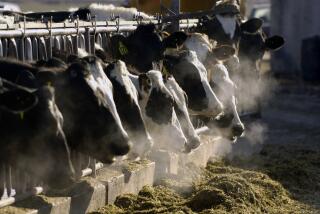The meat looks fresh, but is it?
- Share via
In a grocery store, looks can deceive. This is a place where natural yellow competes with Yellow No. 5 and past-their-prime apples keep a waxy shine.
Even the color of meat can be misleading. In recent years, food companies have been pumping up the red color in hamburger, steaks, tuna and pork products by packaging meat in a mixture of carbon dioxide, nitrogen and a tiny amount of carbon monoxide. This method -- called modified atmosphere packaging -- can give meat a fresh red hue several days after it would have otherwise turned brown.
But not everyone sees carbon monoxide as a welcome addition to their rump roast and cutlets. Consumer groups have called the process deceptive and potentially dangerous. Last month, U.S. Rep. Edward J. Markey (D-Mass.) vowed to introduce a bill banning carbon monoxide in packaged meat if the Food and Drug Administration doesn’t take quick action. (The European Union banned carbon monoxide in meat packaging in 2001.)
Markey’s website states that the gas “makes meat appear fresher than it actually is.”
And last November, Kalsec Inc., a Michigan-based food company that uses plant extracts to preserve the red color of meat, formally petitioned the FDA to reconsider the process. The agency currently calls the process safe.
Reacting to the brouhaha, Kroger Co., the largest U.S. grocery chain, said its stores would not stock ground beef packaged with carbon monoxide.
George Pauli, the FDA’s associate director of food additive safety, says the agency will take another look at carbon monoxide use in meat packaging, but he doesn’t anticipate any policy changes. Carbon monoxide is a poisonous gas, but only trivial amounts end up in meat, Pauli says. (It would take roughly 200 meals to match the carbon monoxide levels from a single cigarette.) Also, Pauli says, treated pieces of meat still lose red color long before they begin to spoil.
“From what we have seen, we don’t have a serious concern,” he says.
But even in a grocery store, where a little deception is the norm, meat treated with carbon monoxide raises an issue: Is it a step forward for people who like red in their red meat, or a sneaky way to sell not-so-fresh food?
For grocery stores, modified atmosphere packaging can be good for the bottom line, says Charles Carpenter, head of the Department of Nutrition and Food Sciences at Utah State University. “Some pieces of meat start to discolor after just a few days. That’s a huge concern for the food industry. Once it turns brown, it has to move to the discount bin.”
Under normal conditions, the iron in meat attaches to oxygen, and the rust-like combination turns meat brown. To slow this reaction, food companies began storing meat in mixtures of nitrogen and carbon dioxide and have done so for at least 40 years without controversy, says Robert Post, director of the Labeling and Consumer Protection Staff with the Food Safety and Inspection Service, a division of the U.S. Department of Agriculture.
Adding carbon monoxide to the mix is a newer twist that was first approved in 1980. It delays browning even further because the gas attaches to a pigment in muscles (myoglobin) to form new, bright-red pigment with lots of staying power. (For the same reason, rosy skin is a common symptom of carbon monoxide poisoning in people.)
If meat were packaged in high concentrations of carbon monoxide, it could stay red “for a long, long time,” Pauli says. As it is, the gas mixture actually in use -- containing just 0.4% carbon monoxide -- preserves color for a few extra days.
No matter how meat is packed, color is a poor guide for freshness and safety, Carpenter says, because the bacteria that spoil meat don’t affect color. “Color becomes unacceptable long before there’s a spoilage problem,” he says.
Color isn’t a good gauge of taste, either. In a 2001 study, Carpenter and colleagues found that consumers strongly preferred the look of raw red steaks over raw brown steaks. After the steaks were cooked, however, no one could tell the difference. “I’ll buy steaks from the discount bin,” Carpenter says. “It all tastes the same on the grill.”
There’s no reason to think that fresh red cuts of meat are safer than slightly aged cuts, says Michael Doyle, director of the Center for Food Safety at the University of Georgia. The bacteria that actually make meat spoil, such as Pseudomonas, can ruin a meal but don’t pose a significant health threat.
Meanwhile, the germs that cause serious food poisoning, such as E. coli or salmonella, can live happily on the freshest cuts of meat. These germs generally contaminate meat in unclean slaughterhouses, sometimes within minutes of slaughter.
Doyle says that packing meat in carbon monoxide slows the growth of germs that cause food poisoning as well as germs that cause spoilage. “Meat can spend a few extra days in the fridge and still taste good,” he says.
To protect themselves, consumers should store meat in a refrigerator and cook it thoroughly. Post says shoppers should always check for signs of spoilage, including “off” odors or stickiness. Packages of wrapped meat may bulge with gases released by spoilage bacteria.
It’s these gases, not carbon monoxide, that should have consumers worried, he says.
More to Read
Eat your way across L.A.
Get our weekly Tasting Notes newsletter for reviews, news and more.
You may occasionally receive promotional content from the Los Angeles Times.










